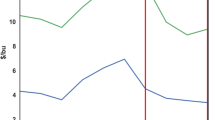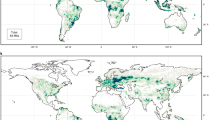Abstract
The need for climate change mitigation and to meet increasing energy demands has led to a rise in the land area under bioenergy crops in many countries. There are concerns that such large-scale land conversion will conflict with food production and impact on the environment. Perennial biomass crops could be grown on more marginal agricultural land. However, for sustainable solutions, biomass yields will need to be sufficient and the wider implications of land-use changes considered. Here, focusing on Miscanthus in England as an example, we combined an empirical model with GIS to produce a yield map and estimated regional energy generation potentials after masking out areas covered by environmental and socio-economic factors which could preclude the planting of energy crops. Agricultural land quality and the distributions of currently grown food crops were then taken into account. Results showed that: (i) regional contrasts occur in the importance of different factors affecting biomass planting; (ii) areas with the highest biomass yields co-locate with food producing areas on high grade land, and; (iii) when such high grade land and unsuitable areas are excluded, a policy-related scenario for increased planting on 350,000 ha utilised 4–28% (depending on the region) of lower grade land and would not necessarily greatly impact on UK food security. We conclude that the GIS-based yield and suitability mapping described here can help identify important issues in bioenergy generation potentials and land use implications at regional or finer spatial scales that would be missed in analyses at the national level.




Similar content being viewed by others
References
Adler PR, Del Grosso SJ, Parton WJ (2007) Life-cycle assessment of net greenhouse-gas flux for bioenergy cropping systems. Ecol Appl 17(3):675–691
Aylott MJ, Casella E, Tubby I, Street NR, Smith P, Taylor G (2008) Yield and spatial supply of bioenergy poplar and willow short-rotation coppice in the UK. New Phytologist. doi:10.1111/j.1469-8137.2008.02396.x
Berry JK (1993) Cartographic modeling: the analytical capabilities of GIS. In: Goodchild MF, Parks BO, Steyaert LT (eds) Environmental modeling with GIS. Oxford University Press, Oxford, pp 58–74
Boorman, DB, Hollis JM, Lilly A (1995) In Hydrology of soil types: a hydrologically-based classification of the soils of the United Kingdom. Report No. 126, CEH, Wallingford
Campbell JE, Lobell DB, Genova RC, Field CB (2008) The global potential of bioenergy on abandoned agriculture lands. Environ Sci Technol. doi:10.1021/es800052w.CCC
Capener P, Scholes H, Ward S, Evans N (2004) REvision 2010—Establishing county/sub regional targets for renewable electricity development to 2010: In: Capener P, Consultants B (ed) Report to the government office for the South West and the South West Regional Assembly
CEH, Centre for Ecology & Hydrology (2008) Land Cover Map 2000. http://www.ceh.ac.uk/sections/seo/lcm2000_home.html. Cited 15 Dec 2008
Centre for Sustainable Energy (2007) Devon Miscanthus and woodfuels opportunities statement. In: Centre for Sustainable Energy B (ed) Report to Devon Wildlife Trust
Christian DG, Poulton PR, Riche AB, Yates NE, Todd AD (2006) The recovery over several seasons of N-15-labelled fertilizer applied to Miscanthus x giganteus ranging from 1 to 3 years old. Biomass Bioenergy 30(1):125–133
Clifton-Brown JC, Stampfl PF, Jones MB (2004) Miscanthus biomass production for energy in Europe and its potential contribution to decreasing fossil fuel carbon emissions. Glob Chang Biol 10(4):509–518
Crosbie T (2008) Why corn will remain the primary ethanol feedstock for the next ten years in the US? Presentation given at the Biobased Industry Outlook Conference, 8 SEPT. Iowa State University, Ames, Iowa
DEFRA Department for Environment, Food and Rural Affairs (2003) http://www.defra.gov.uk/farm/singlepay/furtherinfo/crosscomply/ index. htm)
DEFRA, Department for Environment, Food and Rural Affairs (2007) Opportunities and optimum sitings for energy crops. http://www.defra.gov.uk/farm/crops/industrial/energy/opportunities/index.htm. Cited 15 Dec 2008
DEFRA, Department of Agriculture and Rural Development (Northern Ireland), Welsh Assemby Government and Scottish Government (2007) Agriculture in the United Kingdom 2007. Defra, London, pp 31–37
DEFRA, Department for Environment, Food and Rural Affairs (2008) Agricultural Land Classification. http://www.defra.gov.uk/rds/lgmt/ALC.htm. Cited 15 Dec 2008
Department for Business, Enterprise and Regulatory Reform (2007a) Digest of UK Energy Statistics 2007, TSO, London, 2007
Department for Business, Enterprise and Regulatory Reform (2007b) Regional and local electricity consumption statistics for 2006, Energy Trends, URN 07/79d, pp 21–29, BERR Publications, London, December 2007
DTI, Department of Trade and Industry, Department of Transport and Department (DFT) and Department for Environment, Food and Rural Affairs (DEFRA). (2007) UK Biomass Strategy
Dornburg V, Faaij APC (2001) Efficiency and economy of wood-fired biomass energy systems in relation to scale regarding heat and power generation using combustion and gasification technologies. Biomass Bioenergy 21(1):91–108
EDINA, University of Edinburgh (2008) Maps & data. http://edina.ac.uk/maps/. Cited 15 Dec 2008
English Heritage (2006) Biomass energy and the historic environment. http://www.helm.org.uk/upload/pdf/Biomass-Energy.pdf. Cited 15 Dec 2008
ESRI, Environmental Systems Research Institute (2008) Desktop GIS. http://www.esri.com/products/index.html. Cited 15 Dec 2008
Field CB, Campbell JE, Lobell DB (2007) Biomass energy: the scale of the potential resource. Trends Ecol Evol 23(2):65–72
Finch JW, Hall RL, Rosier PTW, Clark DB, Stratford C, Davies HN, Marsh TJ, Roberts JM, Riche AB, Christian DG (2004) The hydrological impacts of energy crop production in the UK. In: Final Report to ETSU. CEH, Wallingford
Forestry Commission (2008) National inventory of woodland and trees. http://www.forestry.gov.uk/forestry/HCOU-54PG4D. Cited 15 Dec 2008
Gallagher E (2008) Review of the indirect effects of biofuels. Renewable Fuels Agency. http://www.dft.gov.uk/rfa/reportsandpublications/reviewoftheindirecteffectsofbiofuels/executivesummary.cfm
Karp A, Shield I (2008) Bioenergy from plants and the sustainable yield challenge. New Phytol 179(1):15–32
MAGIC, Multi-Agency Geographic Information for the Countryside (2008) Dataset information and download facility. http://www.magic.gov.uk/DataDoc/datadoc.asp. Cited 15 Dec 2008
National Corn Growers Association (2006) How much ethanol can some from corn? Available at: http://www.ncga.com/ethanol/pdfs/2006/HowMuchEthanolCan%20ComeFromCorn.v.2.pdf. Verified 19 SEPT 2008
Natural England (2008a) Energy Crops Scheme. http://www.naturalengland.org.uk/planning/grants-funding/energy-crops/default.htm. Cited 15 Dec 2008
Natural England (2008b) GIS digital boundary datasets. http://www.english-nature.org.uk/pubs/gis/gis_register.asp. Cited 15 Dec 2008
Neukirchen D, Himken M, Lammel J, Czyionka-Krause U, Olfs HW (1999) Spatial and temporal distribution of the root system and root nutrient content of an established Miscanthus crop. Eur J Agron 11:301–309
NSRI, National Soil Resources Institute (2008) LandIS—Land information system, http://www.landis.org.uk/gateway/ooi/welcome.cfm. Cited 15 Dec 2008
Powlson DS, Riche AB, Shield I (2005) Biofuels and other approaches for decreasing fossil fuel emissions from agriculture. Ann Appl Biol 146:193–201
Price L, Bullard M, Lyons H, Anthony S, Nixon P (2004) Identifying the yield potential of Miscanthus x giganteus: an assessment of the spatial and temporal variability of M. x giganteus biomass productivity across England and Wales. Biomass Bioenergy 26(1):3–13
Rafaschieri A, Rapaccini M, Manfrida G (1999) Life Cycle Assessment of electricity production from poplar energy crops compared with conventional fossil fuels. Energ Convers Manage 40(14):1477–1493
Richter GM, Riche AB, Dailey AG, Gezan SA, Powlson DS (2008) Is UK biofuel supply from Miscanthus water-limited? Soil Use Manage 24:235–245
Robinson RA, Sutherland WJ (2002) Post-war changes in arable farming and biodiversity in Great Britain. J Appl Ecol 39:157–176
Rowe RL, Street NR, Taylor G (2009) Identifying potential environmental impacts of large-scale deployment of bioenergy crops in the UK. Renew Sustain Energy Rev 13:271–290
Searchinger T, Heimlich R, Houghton RA, Dong FX, Elobeid A, Fabiosa J, Tokgoz S, Hayes D, Yu TH (2008) Use of US croplands for biofuels increases greenhouse gases through emissions from land-use change. Science 319(5886):1238–1240
Seeruttun S, Crossley CP (1997) Use of digital terrain modelling for farm planning for mechanical harvest of sugar cane in Mauritius. Comput Electron Agric 18(1):29–42
Sherrington C, Bartley J, Moran D (2008) Farm level constraints on the domestic supply of perennial energy crops in the UK. Energy Policy 36:2504–2512
St. Clair S, Hillier J, Smith P (2008) Estimating the pre-harvest greenhouse gas cost of energy crop production. Biomass Bioenergy 32(5):442–452
The Royal Society (2008) Sustainable biofuels: prospects and challenges. The Royal Society, London
von Blottnitz H, Cu, rra n MA (2007) A review of assessments conducted on bio-ethanol as a transportation fuel from a net energy, greenhouse gas, and environmental life cycle perspective. J Cleaner Prod 15(7):607–619
Woesten JHM, Lilly A, Nemes A, Le Bas C (1999) Development and use of a database of hydraulic properties of European soils. Geoderma 90(3–4):169–185
WorldClim (2008) WorldClim version 1.4. http://www.worldclim.org. Cited 15 Dec 2008
Yang YB, Newman R, Sharifi V, Swithenbank J, Ariss J (2007) Mathematical modelling of straw combustion in a 38 MWe power plant furnace and effect of operating conditions. Fuel 86:129–142
Acknowledgements
This paper is the result of collaboration among members of two Research Council UK (RCUK) consortia projects: The constraints mapping is part of the RELU-Biomass project (http://www.relu-biomass.org.uk) funded under the Rural Economy and Land Use programme of the ESRC, BBSRC and NERC and the yield mapping is part of the TSEC-BIOSYS project (http://www.tsec-biosys.ac.uk/) funded by NERC. We are grateful to Natural England for providing details of approved Energy Crop Scheme agreements. Rothamsted Research is and Institute of the BBSRC.
Author information
Authors and Affiliations
Corresponding author
Rights and permissions
About this article
Cite this article
Lovett, A.A., Sünnenberg, G.M., Richter, G.M. et al. Land Use Implications of Increased Biomass Production Identified by GIS-Based Suitability and Yield Mapping for Miscanthus in England. Bioenerg. Res. 2, 17–28 (2009). https://doi.org/10.1007/s12155-008-9030-x
Received:
Accepted:
Published:
Issue Date:
DOI: https://doi.org/10.1007/s12155-008-9030-x




